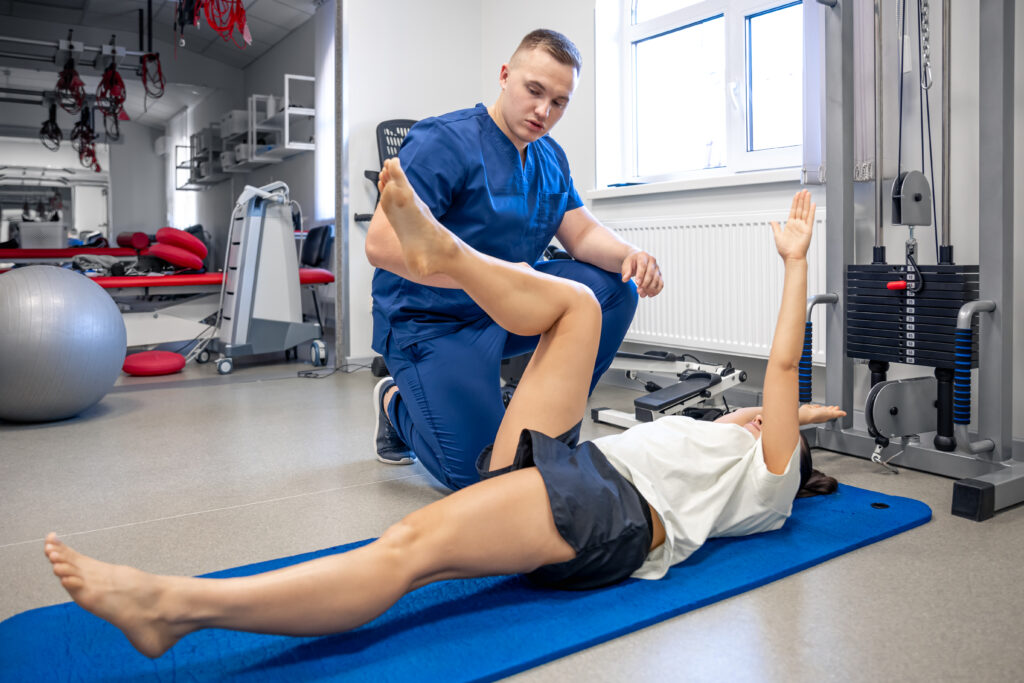6 Key Principles for the Initial Phase of ACL Rehabilitation: Expert Guide to Faster Recovery in Bangalore

An ACL (Anterior Cruciate Ligament) injury can be a life-changing event for athletes and active individuals. Whether it’s caused by a sudden twist on the football field, an awkward landing during a jump, or a road accident, it often leads to pain, instability, and the need for surgical reconstruction.
But surgery is only half the journey — the other half is successful rehabilitation, which determines how well and how quickly you return to your active lifestyle.
At BSI Physiotherapy Bangalore, we specialize in ACL rehabilitation, combining science-backed techniques and hands-on physiotherapy to help patients rebuild strength, mobility, and confidence.
In this blog, we’ll explore the 6 key principles for the initial phase of ACL rehabilitation and how following these steps can ensure a faster, safer, and more complete recovery — especially if you’re undergoing ACL physiotherapy after surgery in Bangalore.
Understanding ACL Reconstruction and Its Recovery Timeline
The Anterior Cruciate Ligament (ACL) plays a vital role in stabilizing your knee joint. When torn, it usually requires ACL reconstruction surgery, where the ligament is replaced with a graft.
Common ACL graft choices in India include:
- Hamstring tendon grafts
- Patellar tendon grafts
- Quadriceps tendon grafts
Each graft type has its advantages, and the rehabilitation timeline slightly differs based on the graft used. Typically, ACL rehabilitation in Bangalore follows a structured plan divided into early, intermediate, and advanced phases.
The initial phase (0–6 weeks) focuses on protecting the graft, restoring mobility, reducing swelling, and reactivating key muscles.
1. Protect the Graft and Surgical Site
The first and most important principle of early ACL rehab is to protect the newly reconstructed ligament. The graft needs time to integrate into the bone tunnels and gain strength. Any excessive strain early on can lead to graft failure.
Physiotherapists at BSI Physiotherapy Bangalore emphasize controlled weight-bearing, proper use of crutches or knee braces, and gradual progression based on your pain and comfort.
Patients who have undergone ACL reconstruction surgery in Bangalore often ask how soon they can walk — the answer depends on surgical technique, graft type, and early healing response.
Our goal during this period is to protect the knee while maintaining basic mobility.
2. Manage Pain and Swelling Effectively
Post-surgery swelling and pain are expected, but prolonged inflammation can delay your recovery.
The best physiotherapists for ACL in Bangalore recommend:
- Cold compression therapy (ice packs)
- Elevation of the leg
- Gentle ankle and quadriceps exercises
- Electrical stimulation to activate muscles
At BSI Physiotherapy, our ACL physiotherapy after surgery protocols are customized to each patient’s needs, ensuring swelling is minimized without compromising joint motion.
Proper pain management in this stage sets the tone for a smooth recovery.
3. Restore Knee Range of Motion (ROM)
Regaining full knee movement is a key goal during the first few weeks after ACL reconstruction surgery.
In the early phase of ACL rehabilitation, the main targets are:
- Achieving full knee extension within 2–3 weeks
- Achieving at least 90 degrees of flexion by the end of week 4
Loss of motion is a common complication if early rehab is neglected.
At BSI Physiotherapy Bangalore, our team guides patients through passive and active range of motion exercises, such as:
- Heel slides
- Stationary cycling (no resistance)
- Wall slides
These gentle movements improve circulation, prevent stiffness, and prepare the knee for later strengthening.
4. Activate Quadriceps and Hamstrings
Muscle inhibition is one of the biggest challenges after ACL surgery. The quadriceps and hamstrings are critical for knee stability and movement, but they often weaken significantly after surgery.
Our ACL rehabilitation protocol in Bangalore includes:
- Quadriceps setting (quad sets)
- Straight leg raises
- Bridges
- Hamstring curls
- Electrical stimulation (NMES) for muscle activation
By progressively increasing resistance, we ensure strength returns evenly, avoiding muscle imbalances that could affect gait and stability.
5. Rebuild Balance and Proprioception
Rebuilding proprioception — your body’s sense of joint position — is an essential part of ACL rehab.
After injury or surgery, your knee’s ability to sense movement and maintain stability diminishes. This increases the risk of re-injury, especially in athletes.
At BSI Physiotherapy Bangalore, our therapists use:
- Balance boards
- Foam pads
- Single-leg stance drills
- Eyes-closed balance challenges
These exercises help retrain your brain and muscles to work together, improving knee control and preparing you for more advanced functional movements.
6. Follow a Structured, Supervised Rehabilitation Plan
Every ACL recovery journey is unique. Some patients may progress faster, while others require more time and support.
A structured and supervised ACL rehabilitation plan ensures steady improvement and prevents overloading the graft too early.
At BSI Physiotherapy, our ACL rehabilitation in Bangalore program includes:
- Regular progress assessments
- Individualized exercise progression
- Manual therapy for soft tissue release
- Strength and conditioning sessions
The early phase may last 6 weeks, followed by progressive strengthening, jogging, and agility training.
Most athletes return to sport after ACL surgery in India within 6–9 months — depending on dedication to physiotherapy and recovery goals.
Cost and Success Rate of ACL Rehabilitation in Bangalore
Many patients ask, “What is the cost of ACL rehabilitation in Bangalore?”
The cost varies based on clinic facilities, therapist experience, and session frequency.
At BSI Physiotherapy Bangalore, we provide affordable ACL rehabilitation packages with world-class care to ensure accessibility for all.
The ACL reconstruction success rate in India is above 90%, especially when surgery is followed by a complete physiotherapy program. Early rehab and professional supervision make a huge difference in long-term outcomes.
Common FAQs on ACL Rehabilitation
1. How soon can I start physiotherapy after ACL surgery?
In most cases, physiotherapy starts within 3–5 days after surgery. Early motion helps reduce stiffness and promote healing.
2. How long does it take to recover fully after ACL reconstruction?
Daily activities resume in 6–8 weeks, while athletes typically return to sport within 6–9 months.
3. Can physiotherapy alone heal a torn ACL?
Partial tears may improve with physiotherapy, but complete ACL tears usually require surgical reconstruction followed by rehab.
4. What is the timeline for ACL recovery post-op?
- Phase 1 (0–6 weeks): Pain control, motion restoration
- Phase 2 (6–12 weeks): Strengthening
- Phase 3 (3–6 months): Dynamic training
- Phase 4 (6–9 months): Return to sport
5. Why choose BSI Physiotherapy for ACL rehab in Bangalore?
Because we offer expert-driven, result-oriented programs backed by advanced physiotherapy technology, personalized attention, and athlete-centric care.
Conclusion
The journey after an ACL reconstruction surgery in Bangalore requires discipline, expert supervision, and structured physiotherapy.
By following these 6 key principles for the initial phase of ACL rehabilitation, you can ensure a faster and safer comeback — whether you’re an athlete aiming to return to the field or someone simply wishing to move pain-free again.
At Best Physiotherapy Clinic in Bangalore, we’re committed to helping you recover stronger than ever.
Book your consultation today and take the first confident step in your ACL rehabilitation journey in Bangalore.
